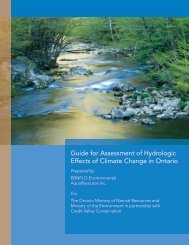15 page summary of thesis
15 page summary of thesis
15 page summary of thesis
You also want an ePaper? Increase the reach of your titles
YUMPU automatically turns print PDFs into web optimized ePapers that Google loves.
2005 ONE Dissertation Award, abstract #3change in inflight meal concepts). The two decisions involved very different motivations.With the engine decision, the financial motivations were predominantly for future savingsin emissions charges whereas the financial motivations for ‘greening’ inflight servicewere identified as being primarily through the realisation <strong>of</strong> eco-efficiencies. The enginedecision also demonstrated that an environmental champion within a firm is an importantcatalyst in pushing environmentally-favourable decisions forward.There may be several factors that collaborate together to motivate a firm’s level <strong>of</strong>corporate greening. For example, SAS’s quest to improve its image was a combination<strong>of</strong> responding to the need to be environmentally and socially responsible for theScandinavian people, trying to even out the playing field with respect to other forms <strong>of</strong>transport and getting the message across to regulators that the airline industry is makingan effort (and therefore avoid harsher legislation for the industry in the future). Identifyingand understanding a company’s motivations for environmental commitment reveals thecomplexities and intertwining aspects <strong>of</strong> corporate greening. For example, while airlineshad little control over the terrorist attacks <strong>of</strong> September 11, they did have considerablecontrol in how they responded to the crisis. Herein lies the danger <strong>of</strong> blanketclassification <strong>of</strong> ‘internal’ and ‘external’ drivers. The complex and overlappingrelationship between external and internal drivers make a clear distinction between thetwo impossible. It is important to recognise that corporations not only respond to externalconditions, but they can also shape those conditions through interactive engagementwith the wider context including other airlines and international agencies such as theIATA. From the analysis <strong>of</strong> the two decisions that were examined, two main conclusionscan be drawn with regards to motivations for environmental commitment within SAS.Firstly, the main drivers for SAS are the confluence <strong>of</strong> relationships between thesystems <strong>of</strong> drivers that were identified in Renn’s (2001) systems <strong>of</strong> influence (e.g.The motivations for environmental commitment in the airline industry: A case study <strong>of</strong> Scandinavian Airlines 7









